Jeff Lowe's Eiger Metanoia finally repeated by Thomas Huber, Stephan Siegrist and Roger Schaeli
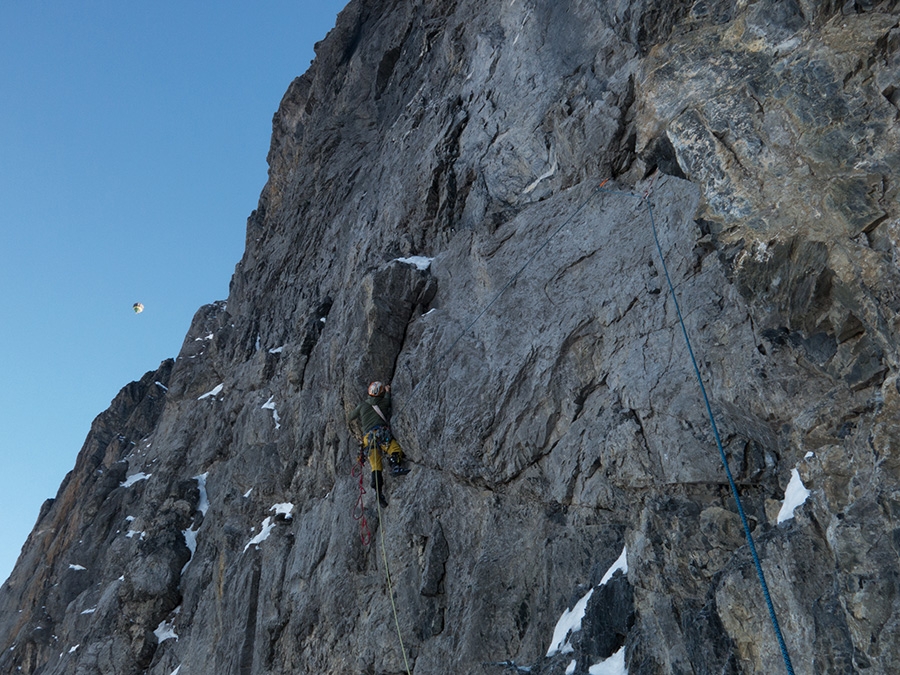
 1 / 8
1 / 8 Archive Metanoia
Archive Metanoia
A quarter of a century after Jeff Lowe’s epic first ascent of Metanoia up the North Face of the Eiger, Germany’s Thomas Huber and Switzerland’s Stephan Siegrist and Roger Schaeli have finally made the first repeat of this legendary alpine outing. Metanoia was forged solo over a period of nine days in winter 1991 by Lowe, during which the American climbed a direct line between the Japanese and Harlin routes without bolts and fixed ropes, and faced utterly adverse conditions before taking a near-fatal fall on his last day on the face. What resulted from 27 February to 4 March 1991 was an audacious, groundbreaking ascent, both in terms of style and commitment, which also provided Lowe with a greater, more enlightened outlook on life in general.
Over time the route has become shrouded in mystery, also because it has been attempted in the past but to no avail. In late December Huber, Schaeli and Siegrist made their first attempt, but were forced to abort circa 70 meters left of the Central Ledge after their bivvy due to worsening weather. A second attempt followed on 28 December, but this too came to a halt when a storm set it. The trio returned on 29 December and, climbing directly from the famous Stollenloch, embarked on their their attempt. After a bivvy close to the Central Ledge, where Lowe endured his fifth night out on the face, the trio continued upwards and reached the summit in the evening on 30 December 2016. While Lowe climbed his line without bolts, Huber, Siegrist and Schaeli installed an 8mm bolt at a belay to "avoid the risk of the entire rope team falling." Furthermore, they used a 10mm bolt in a pitch before the Hinterstoisser Traverse which they believe It was probably drilled to support the film team of the documentary "Metanoia."
Jeff Lowe, who was diagnosed with a neuro-degenerative disorder 16 years ago that has tied him to a wheelchair, was understandably excited about the first repeat of his “Metanoia”. He stated: "Thomas Huber called us to share the good news that he, Roger Schaeli and Stephan Siegrist succeeded on "Metanoia". I'm happy and gratified that they found the route to be hard, bold, beautiful and 'visionary.' Their confirmation of the quality of Metanoia is very gratifying and quite humbling. Best of all, Thomas understands what I was doing with the climb; which was trying to create an example of how alpinists can progress in an environmentally conscious way that honors the spirit of extreme alpinism."
EIGER METANOIA by Thomas Huber
Grades of 7/A4/M6 sound pretty adventurous. Especially in the 1800 meters of the north face of the Eiger. Behind these facts lies a mysterious name: Metanoia. It's a Greek term and means as much as fundamental change of thinking, a new view of the world. The climb promises to be a challenging adventure.
Jeff Lowe, an exceptional American alpinist, tackled the snowy north face of the Eiger all by himself in February 1991. His goal was a direct, unclimbed line to the summit. His life was extremely turbulent at the time. He was in a tough spot personally and financially he had hit rock bottom. Some of his friends thought his undertaking was a suicidal act. However harsh the reality of Jeff's life was, he operated like clockwork in the steep, icy world of the Eiger's north face. He bravely faced the storms, snow-covered rock slabs and mastered passages of technical climbing up to A4, often far from any decent protection. It wasn't a "borderline ascent" as we alpinists like to call adventures of this kind. Jeff was in a whole other world, far from the usual reality. Here only your intrinsic instincts and intuition keep you alive. His love for his daughter was his sole connection to the "normal" world.
Jeff reached the summit after nine days. His friends brought him back to the world via helicopter right before another storm hit the Eiger. He called his nine-day vacuum "Metanoia." His life had a new perspective. From then on he took to challenges with the mindset to work hard on himself with refinement and sensitivity and to have fun at the same time.
His story inspired me and made me curious. There are no exact descriptions of the route. No one knows the exact path or how hard it really is. The route has been tried several times to date but it hasn't been repeated yet. And that mysterious name. It sounds like the gateway to fundamental insights!
Swiss alpinist Stephan Siegrist, who had been on the Eiger over 30 times, was immediately drawn to the story. He brought Swiss climber Roger Schaeli on board, who had been in the neighboring Japanese Direttissima twice. Jeff gave me some valuable advice about the path of the route. So the adventure Metanoia could begin!
I drove to Switzerland the week before Christmas in perfect weather. "It's now or never!" I thought. We climbed the buttress of the Eiger's north face in the light of our headlamps and traversed a difficult crack to the left, the first crux pitch of the Heckmair Route, to the Toni-Kurz-Overhang. It's a very devastating feeling to stand beneath the spot where the alpinist Toni Kurz died exactly 80 years ago, hanging from his rope in front of his rescuers, uttering his last words "I can't anymore."
It got light, everything was quiet, all was good. I climbed farther to the left, to the beginning of Jeff's Metanoia, quietly thinking of home. Steff got ready to lead. It was cold, no wind, perfect weather! Roger belayed, I was feeling cold and Steff worked his way up the first pitch over great rock. An old knotted rappel cord eased our ascent over the compact part of the route. We progressed faster than we thought we would but the aid rope took the adventure out of it. We cut the rope out as far as possible with our knife. We crossed the Hinterstoisser Traverse. Roger was busy with birdbeaks, hooks and spindrift for the next 35 meters and two hours. We now realized how Jeff must have fought back then!
The days are short, we reach the end of the second ice field as the sun set. We established a bivvy after an hour hacking ice and couldn't wait for our warm soup. Roger and Steff, who have both spent countless hours in bivvys in this wall, tell jokes and laugh and feel comfortable. I on the other hand, was a little anxious. We were, after all, in the wall of walls, on the Eiger. I was here with my brother Alexander and friends from Berchtesgaden exactly 20 years ago in winter. It took us 3 days in extremely cold conditions to climb the classic Heckmair Route! Today conditions are far better, almost perfect. But we were attempting one of the hardest routes on the Eiger, a Direttissima, the Metanoia. I could faintly make out the bulging rock face above us. It looked threatening, hard and crazy. I tried to laugh about the jokes from time to time but I was too encompassed in Jeff's story. Our sleeping bags made the bivvy bearable. We have a saying: "A good one sucks it up and doesn't complain." But none of us could really sleep. Metanoia was on our minds, followed us in our waking dreams. Maybe the jokes from the evening were a way of dealing with the stress of the situation considering what was in store for us.
We left the warmth of our sleeping bags at 5 in the morning, into the cold of the night. Our cooker hissed as it melted snow. We had some warm coffee and a granola bar at 5.30 and departed. We zigzaged over mixed passages and small ice fields to the first large part of the wall. I sorted a double set of cams, stoppers, hooks, and beaks on my harness. I was ready for Metanoia! Four pitches took me four hours and the wall offered everything climbing has in store: parts where falling isn't an option, at least not a very painless one, rope-traverses, technical passages, runouts in bad rock with sketchy protection and complicated belays in questionable rock. The terrain above us leaned back a little. I was very glad everything went well. I was also totally depleted mentally. Steff took the lead immediately. It would be good to reach the central ledge where we have the best possibility to find a place for a bivvy. We realized our potential right there. Our team functioned perfectly, we complemented each other. The experience Steff and Roger have on the Eiger is the perfect prerequisite. We had what Jeff didn't. He was alone, he had never been in the wall before, he could only rely on himself. I tried to imagine myself in his place after every hard passage that lay behind me. His fight passed in front of my inner eye like a movie. What he accomplished is really just madness.
Steff climbed along steep ice and brittle black rock to the central ledge as the stars sparkled above us. The days are short, damn short! It's only 5pm and it was pitch black. The "central ledge" doesn't live up to its name. It's small, aslope and not a place where the three of us could set up a bivvy. Roger traversed 70 horizontal meters to the left to a recess. Finally a good spot for our nightly rest. It was already 7pm as we reached him and snow began to fall. It was good to be where we were, a spectacular bivvy! A mighty overhang protected us from rock fall and spindrift, the wall below us broke off in a downward slope. An oasis in the wild world of the Eiger, our eagle's nest. We ate but the jokes were restrained. We asked Charly Gabl for a weather forecast and he predicted stormy times. The snow wouldn't be the problem, it would have receded during the night. The wind, however, was predicted to blow from the south. That meant Foehn, an alpine storm, with wind speeds up to 60, 70 kilometers per hour. Steff said we wouldn't have a chance. Spindrift would make climbing around the summit region impossible and the rock fall caused by the wind would be a whole different story. We huddled in our sleeping bags with low spirits. Then all of a sudden it was light as day! We weren't dreaming. A helicopter floated before us in the snow flurry and lit up our bivvy with its search lights. We gave the sign that we're ok. We weren't the object of his nightly search. He flew over to the Exit Cracks. We witnessed a long-line rescue of two mountaineers from the Spider in the next hour. At night during light snowfall. Crazy! It was almost midnight, half the night was over. It was finally quiet and the snow gave it a feeling like Christmas.
A lot had changed in the north face by early morning. The black, threatening bastion above us was white from the snow. It was windy, clouds surrounded us and it was very uncomfortable. Or better: it was winter! Not a good day for the Eiger. The only reasonable decision was to retreat. We began to descend on almost artsy, sometimes questionable rapells. We were constantly accompanied by snow-dust avalanches and spindrift. We crossed the ice fields to the Hinterstoisser Traverse, then the difficult crack. We finally reached the Stollenloch after eight hours. We were safe and the only thing we looked forward to was Christmas at home. Wind speed measured in the peak region of the Eiger that day were 180 kilometers per hour.
The weather gave us another chance just after Christmas Eve on the 27th. Metanoia wouldn't let us go. Again were below the Toni-Kurz-Overhang. We set up ropes in the first pitches and wanted to go for it tomorrow! Our new strategy was to make it through the wall with just one bivvy after installing the ropes. Today Roger was on lead. A crafty and hard challenge with beaks, hooks and sketchy mixed passages. It took us longer than expected because we had cut out the aid ropes in many parts. It was cold but we managed to do exactly what we had planned.
Storm hit again on the 28th. We climbed over the buttress and faced spindrift and snow-dust avalanches from all sides. There was no point in continuing. We fled to the Stollenloch. We sat in front of Swiss hash brows and beers two hours later. We wouldn't have had a chance that day. But if we wanted to spend New Year's Eve with our family everything had to be perfect from now on.
On December 29th the wind calmed and Charly gave us green light for the next days. We took a shortcut and climbed to the wall directly from Stollenloch. We traversed the ice fields over to our fixed ropes. Two hours later we were on our way as a rope team again. Our goal was to reach the central ledge and our bivvy at Eagles Nest. We each led the pitches we had a week before. We were fast, spirits were high. We reached the central ledge at 4pm. Steff installed a rope on the next pitch while I traversed to the bivvy 70 meters to the left. We named this exposed traverse Eagle's Traverse. The stars began to sparkle in the sky again. The lights from Grindelwald sparkled below us. Many people down there were preparing for the new year or sat together with friends, talking about the passing year with a beer. We laid in our sleeping bags in an entirely different reality, in the world of Metanoia.
The next day, on the 30th, Steff was on the sharp end and found Jeff's path through brittle cracks and dihedrals. I took over the sharp end back at Eagle's Traverse. Roger took the lead again after two pitches. A little runout over a slab, then an overhanging funnel. Jeff described this as the nicest pitch of the route. Nice to me is something else. Everything here is loose, draw rock. It's serious and extremely steep. Roger climbed a full 60 meter pitch to Hermit Cave below the Fly. a small ice field on the right above the Spider. Jeff spent another two nights in this downward facing recess. We only spent a few minutes here. It was two o'clock and we had a chance of reaching the top that day. We climbed the small ice field of the Fly to the Exit Cracks. One more difficult, crumbly pitch and we got to the Japanese Direttissima. Roger knows it well. He was our joker that day. He progressed fast and he climbed to the last ice field along old fixed ropes and ring-bolts. Jeff left his backpack here. It was recovered in 2011 by Josh Wharton while making the documentary "Metanoia." We climbed the last 20 meters in twilight. Then a last sign of Jeff's: an old bong with blue marking (a large metal piton, used as an anchor, Editor's note). He soloed from here on to the top out after nine days in the wall, back to life.
Behind us lay a cold adventure of a crazy route through the Eiger's north face! The sun that had already set left the sky in an unreal light. Today we understood why this here is called "Metanoia."
With Metanoia Jeff was able to prove that you can accomplish impossible challenges just with your heart. He set new standards in alpinism with his ascent. This Metanoia, the new way of seeing the world and this new mind-set on life help Jeff today to approach his battle with his illness with cheerfulness, courage and love. This attitude is what inspires me in my life. We, Steff Roger and I, are thankful to be able to live Metanoia for five days. Tomorrow we celebrate a new year!



 Copia link
Copia link

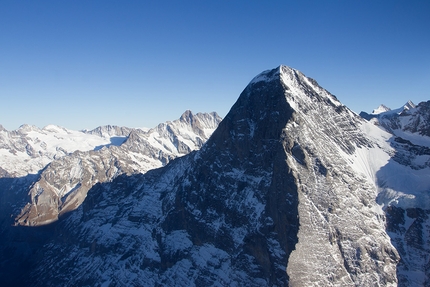
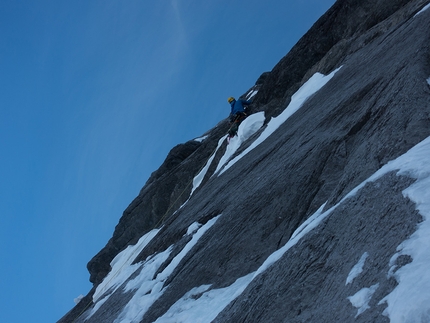
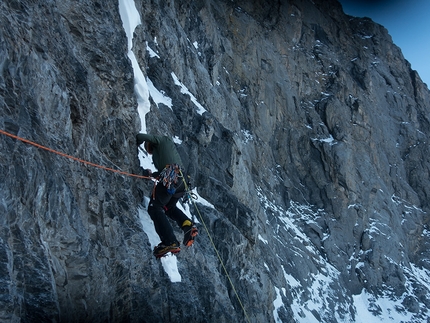
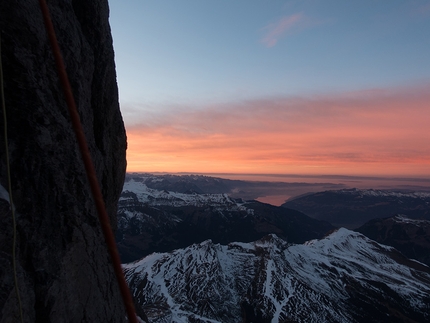
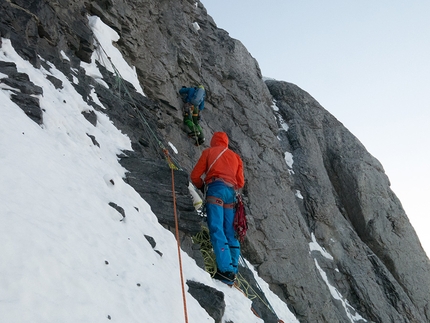
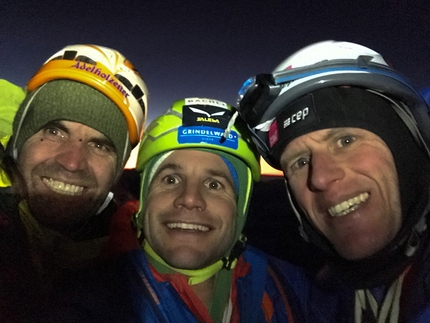
 See all photos
See all photos






















